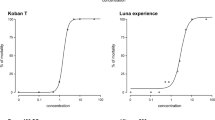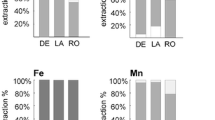Abstract
Testing of effects on earthworms and non-target foliar arthropods is an integral part of the ecotoxicological risk assessment for the authorization of plant protection products. According to the new data requirements, which came into force in 2014 for active substances and in 2016 for plant protection products, the chronic earthworm toxicity test with Eisenia fetida based on reproductive, growth, and behavioral effects instead of the acute earthworm toxicity test based on mortality, has to be conducted routinely. Additional testing of effects on soil arthropods (Folsomia candida, Hyposaspis aculeifer) is required if the risk assessment of foliar applications raises concerns regarding non-target foliar arthropods (Aphidius rhopalosiphi, Typhlodromus pyri) or if the product is applied directly on or into the soil. Thus, it was investigated whether the sublethal earthworm endpoint is more sensitive than the sublethal soil arthropod endpoint for different types of pesticides and whether the risk assessment for non-target arthropods would trigger the testing of effects on soil arthropods in the cases where soil arthropods are more sensitive than earthworms. Toxicity data were obtained from Swiss ecotoxicological database, EFSA Conclusions and scientific literature. For insecticides and herbicides, no general conclusion regarding differences in sensitivity of either earthworms or soil arthropods based on sublethal endpoints were possible. For fungicides, the data indicated that in general, earthworms seemed to be more sensitive than soil arthropods. In total, the sublethal F. candida or H. aculeifer endpoint was lower than the sublethal E. fetida endpoint for 23 (34 %) out of 68 active substances. For 26 % of these 23 active substances, testing of soil arthropods would not have been triggered due to the new data requirement. These results based on sublethal endpoints show that earthworms and soil arthropods differ in sensitivity toward certain active substances and that the risk assessment for non-target foliar arthropods did not always trigger soil arthropod testing in the cases where soil arthropods were more sensitive than earthworms.




Similar content being viewed by others
References
Barateiro Diogo J, Natal-da-Luz T, Sousa JP, Vogt C, Nowak C (2007) Tolerance of genetically characterized Folsomia candida strains to phenmedipham exposure—a comparison between reproduction and avoidance tests. J Soils Sediments 7:388–392
Campiche S, Becker-Van Slooten K, Ridreau C, Tarradellas J (2006) Effects of insect growth regulators on the nontarget soil arthropod Folsomia candida (Collembola. Ecotoxicol Environ Saf 63:216–225
Candolfi MP, Barret KL, Campbell PJ, Forster R, Grandy N, Huet MC, Lewis G, Oomen PA, Schmuck R, Vogt H (2000) Guidance document on regulatory testing and risk assessment procedures for plant protection products with non-target arthropods. From the ESCORT 2 Workshop (European Standard Characteristics of Non-Target Arthropod Regulatory Testing), CRC SETAC, Boca Raton, FL
Daam MA, Leitao S, Cerejeira MJ, Sousa JP (2011) Comparing the sensitivity of soil invertebrates to pesticides with that of Eisenia fetida. Chemosphere 85:1040–1047
European Commission (2002) Guidance document on terrestrial ecotoxicology. Draft Working Document SANCO/10329/2009, rev.2, final. European Commission, Luxembourg
European Commission (2009) Regulation (EC) No 1107/2009 of the European Parliament and of the Council of 21 October 2009 concerning the placing of plant protection products on the market and repealing Council Directives 79/117/EEC and 91/414/EEC. Official Journal of the European Union
European Commission (2011) Commission Regulations (EU) No 546/2011 of 10 June 2011 implementing Regulation (EC) No 1107/2009 of the European Parliament and of the Council as regards uniform principles for evaluation and authorisation of plant protection products. Off J Eur Union, Brussel
European Union (2011a) Commission Regulations (EU) No 544/2011 of 10 June 2011 implementing Regulation (EC) No 1107/2009 of the European Parliament and of the Council as regards the data requirements for active substances. Official Journal of the European Union, Brussel
European Union (2011b) Commission Regulations (EU) No 545/2011 of 10 June 2011 implementing Regulation (EC) No 1107/2009 of the European Parliament and of the Council as regards the data requirements for plant protection products. Off J Eur Union, Brussel
European Union (2013a) Commission Regulations (EU) No 283/2013 of 1 March 2013 setting out the data requirements for active substances, in accordance with Regulation (EC) No 1107/2009 of the European Parliament and of the Council concerning the placing of plant protection products on the market. Off J Eur Union
European Union (2013b) Commission Regulations (EU) No 284/2013 of 1 March 2013 setting out the data requirements for plant protection products, in accordance with Regulation (EC) No 1107/2009 of the European Parliament and of the Council concerning the placing of plant protection products on the market. Off J Eur Union
Frampton GK, Jansch S, Scott-Fordsmand JJ, Rombke J, Van den Brink PJ (2006) Effects of pesticides on soil invertebrates in laboratory studies: a review and analysis using species sensitivity distributions. Environ Toxicol Chem 25:2480–2489
Hartnik T, Sverdrup LE, Jensen J (2008) Toxicity of the pesticide alpha-cypermethrin to four soil nontarget invertebrates and implications for risk assessment. Environ Toxicol Chem 27:1408–1415
ISO (1999) Soil quality—inhibition of reproduction of Collembola (Folsomia candida) by soil pollutants. International Organization for Standardization No. 11269
Jaensch S, Frampton GK, Rombke J, Van den Brink PJ, Scott-Fordsmand JJ (2006) Effects of pesticides on soil invertebrates in model ecosystem and field studies: a review and comparison with laboratory toxicity data. Environ Toxicol Chem 25:2490–2501
Krogh PH (1995) Does a heterogeneous distribution of food or pesticide affect the outcome of toxicity tests with Collembola? Ecotoxicol Environ Saf 30:158–163
OECD (2004) Guideline for testing of chemicals No. 222. Earthworm reproduction test (Eisenia fetida/ Eisenia andrei). Organisation for Economic Cooperation and Development Paris. France
OECD (2008): Guideline for testing of chemicals No. 227. Predatory mite (Hypoaspis (Geolaelaps) aculeifer) reproduction test in soil. Organisation for Economic Cooperation and Development Paris. France
OECD (2009): Guideline for testing chemicals No. 232. Collembolan reproduction test in soil. Organisation for Economic Cooperation and Development Paris. France
Pelosi C, Toutous L, Chiron F, Dubs F, Hedde M, Muratet A, Ponge JF, Salmon S, Makowski D (2013) Reduction of pesticide use can increase earthworm populations in wheat crops in a European temperate region. Agric Ecosyst Environ 181:223–230
Pelosi C, Barot S, Capowiez Y, Hedde M, Vandenbulcke F (2014) Pesticides and earthworms. A review. Agron Sustain Dev 34:199–228
Stämpfli C (2001) Etude des relations entre l’exposition de Folsomia candida à un micropollutant organique et les effets observés à différents niveaux d’organisation biologique: utilité des biomarqueurs comme outil prévisionnel, École Polytechnique Fédérale de Lausanne, Lausanne, 85 pp
Yasmin S, D’Souza D (2010) Effects of pesticides on the growth and reproduction of earthworm: a review. Appl Environ Soil Sci 1–9
Acknowledgements
Authors would like to thank Dr. Otto Daniel for his very valuable comments on the manuscript.
Author information
Authors and Affiliations
Corresponding author
Additional information
Responsible editor: Philippe Garrigues
Rights and permissions
About this article
Cite this article
Kohlschmid, E., Ruf, D. Is the risk for soil arthropods covered by new data requirements under the EU PPP Regulation No. 1107/2009?. Environ Sci Pollut Res 23, 23884–23891 (2016). https://doi.org/10.1007/s11356-016-7536-x
Received:
Accepted:
Published:
Issue Date:
DOI: https://doi.org/10.1007/s11356-016-7536-x




